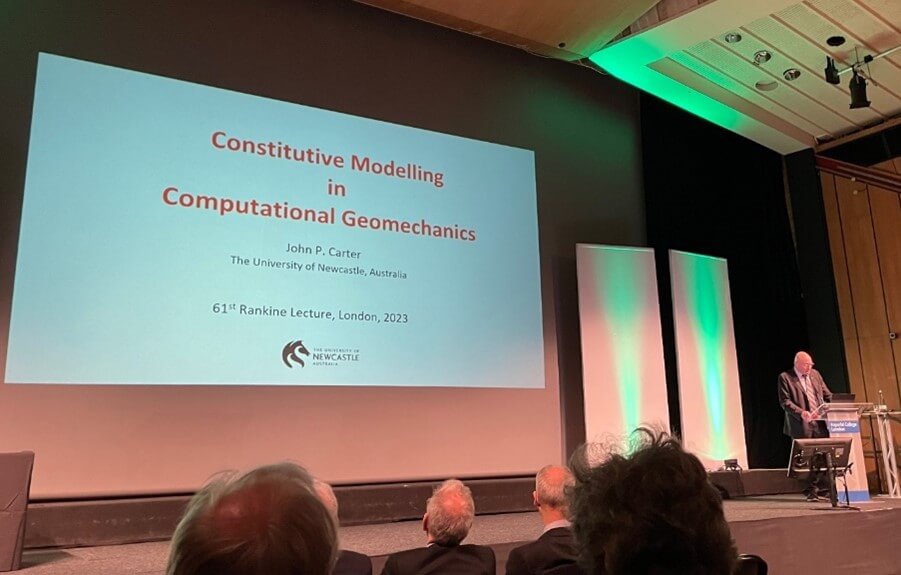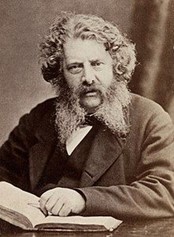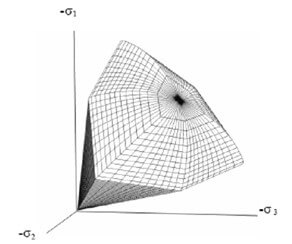2023 Rankine Lecture – Constitutive modelling in computational geomechanics
by Andrew Lees, on april 13, 2023
The 61st Rankine Lecturer, John Carter, addressed the complex topic of numerical modelling of geomechanics and succeeded in making this both interesting and understandable to a non-specialist audience of British Geotechnical Association members and guests. He stressed the need to keep models as simple as possible and the crucial importance of selecting the appropriate model for the specific geotechnical task and ensuring that it has been correctly calibrated.

.jpg)
Figure 1 - Emeritus Professor John Carter
What is the Rankine Lecture?
Arthur Casagrande presented the first Rankine Lecture - organised by the British Geotechnical Association (BGA) - in 1961, and the annual Rankine Lecture is now viewed as the most prestigious geotechnical invited lecture globally. Lecturers alternate annually, one year from the UK and the next from outside the UK. The list of Rankine lecturers is a who’s who of the geotechnical ‘greats’ over the past 60 years and includes Sir Alec Skempton, Alan Bishop, Ralph Peck, Harry Poulos and many others, whose contributions to geotechnics have been immense. The lectures are published in the international journal Géotechnique.
Who was William Rankine?

Figure 2 - William Rankine
The BGA Rankine Lecture series commemorates William John Macquorn Rankine (1820-1872), professor of Civil Engineering at Glasgow University. Rankine was a mechanical engineer and mathematician who was a founding contributor to the science of thermodynamics. Like many engineers of his time, his career and scientific interests were multi-faceted. His other major contributions were in naval architecture, fatigue failure of metals and shock wave mechanics.
Rankine’s significant contribution to soil mechanics, commemorated by the BGA with the Rankine Lecture, was his development of lateral earth pressure theory as it relates to retaining walls. His solution predicts active and passive earth pressure for cohesionless soils.
The 61st Rankine Lecturer – John Carter
John Carter has over 40 years’ experience in geotechnics, as a lecturer, researcher and consultant. He has had a long and distinguished academic career, including being Director of the Centre for Geotechnical Research and Head of the Department of Civil Engineering at the University of Sydney, and Dean of Engineering at the University of Newcastle, Australia, where he is now an emeritus professor.
Prof Carter’s research interests include analytical and numerical modelling for geotechnics and soil-structure interaction as well as tunnelling and offshore foundations. He chose numerical modelling and the constitutive modelling of soil and rock as the subject area for his Rankine Lecture, a topic that has interested him throughout his career.
Constitutive modelling in computational geomechanics – John Carter
In this 61st Rankine Lecture, John Carter shared his interpretation of the last 50 years of development in numerical modelling of soils and rock. He then focussed the major part of his lecture on the importance of understanding the capabilities and limitations of the advanced models in use today. In particular, Carter stressed the need for users to take great care in selecting an appropriate constitutive soil model for the specific geotechnical problem to be solved, and then to ensure that the model has been correctly calibrated. His closing statement included a plea for those “brave enough to try and predict the future” using numerical modelling, to simplify their models as much as possible.
What is a constitutive soil model?
Soil constitutive models are mathematical relationships between stresses, strains and - in some cases - time. They are an essential component of computational modelling to predict the behaviour of soil and rock. Various constitutive models have been developed, from simple models such as Hooke’s and the Mohr-Coulomb linear elastic perfectly plastic models to the highly complex, hypoelastic, hyperelastic and hardening soil models. Models must be calibrated against real data obtained from laboratory testing. As Carter points out, such models can never be complete. They include idealisations and simplifications, and users need to be aware of these and the limitations and shortcomings they encompass.

Figure 3 - Hardening Soil model for cohesionless soil –
from Kok et al (2009) A Review of Basic Soil Constitutive Models for Geotechnical Application
How Tensar uses soil constitutive modelling?
Tensar developed the Tensar Stabilised Soil Model (TSSM): a soil constitutive model that correctly predicts the behaviour of a mechanically stabilised layer incorporating a Tensar geogrid.
Using this constitutive model, Tensar has developed innovative new design methodologies.
- The Lees Approach to Applied Mechanical Stabilization™ (LAAMS) for the design of mechanically stabilised road foundations, Click here to download a technical summary.
- The T-value method for determining the bearing capacity of mechanically stabilised layers, used for design of working platforms
These have been incorporated into Tensar+ software and other modules are in development.
The TSSM is a linear-elastic perfectly plastic (LEPP) constitutive model with a non-linear failure envelope formulated in terms of principal stresses. It incorporates a linear variation of enhanced strength with distance from the geogrid plane. It is the first soil constitutive model to correctly model the response of soil mechanically stabilised with a geogrid. It is available from Tensar and has already been implemented into leading FEA software tools, such as PLAXIS 2D and 3D. Take a look at our video for a broader explanation.
Calibration of the Tensar soil constitutive model for stabilised soil
Carter stressed the importance of correct calibration of soil constitutive models. Tensar calibrated the TSSM by conducting an extensive programme of large diameter (0.5m) triaxial testing using a variety of soil types and geogrid grades. The constitutive model has been validated by very large scale plate load testing and full-scale accelerated trafficking tests, comparing stabilised and non-stabilised layers. The methodology has been peer reviewed and published.
Reference
- Lees AS and Clausen J (2020). Strength envelope of granular soil stabilized by multi-axial geogrid in large triaxial tests, Canadian Geotechnical Journal 57(3) 448-452.


